Economics of Property and Construction: Hong Kong Rail Project Report
VerifiedAdded on 2022/11/13
|13
|3704
|410
Report
AI Summary
This research report, prepared by ECO5 Ltd for APCO PLC, provides an in-depth economic analysis of the Hong Kong high-speed rail project. The report examines the rationale for a welfare approach, detailing infrastructure, operational, and external costs, along with the social and economic benefits. It explores how externalities are treated through environmental mitigation and assesses them using cost-benefit analysis, multi-criterion analysis, and qualitative MCA. The report delves into the discount rate's significance and how the investment aligns with urban growth models, specifically the Hoyt model. The report also discusses the assessment methodology, including investment costs, maintenance, and operation costs, travel costs, and health-related costs associated with air pollution. It emphasizes the importance of considering the land costs within the quantitative MCA to account for potential underestimations and overall prices. Furthermore, the report mentions the use of lower discount rates for rail projects and explains how the investment aligns with the Hoyt urban growth model.
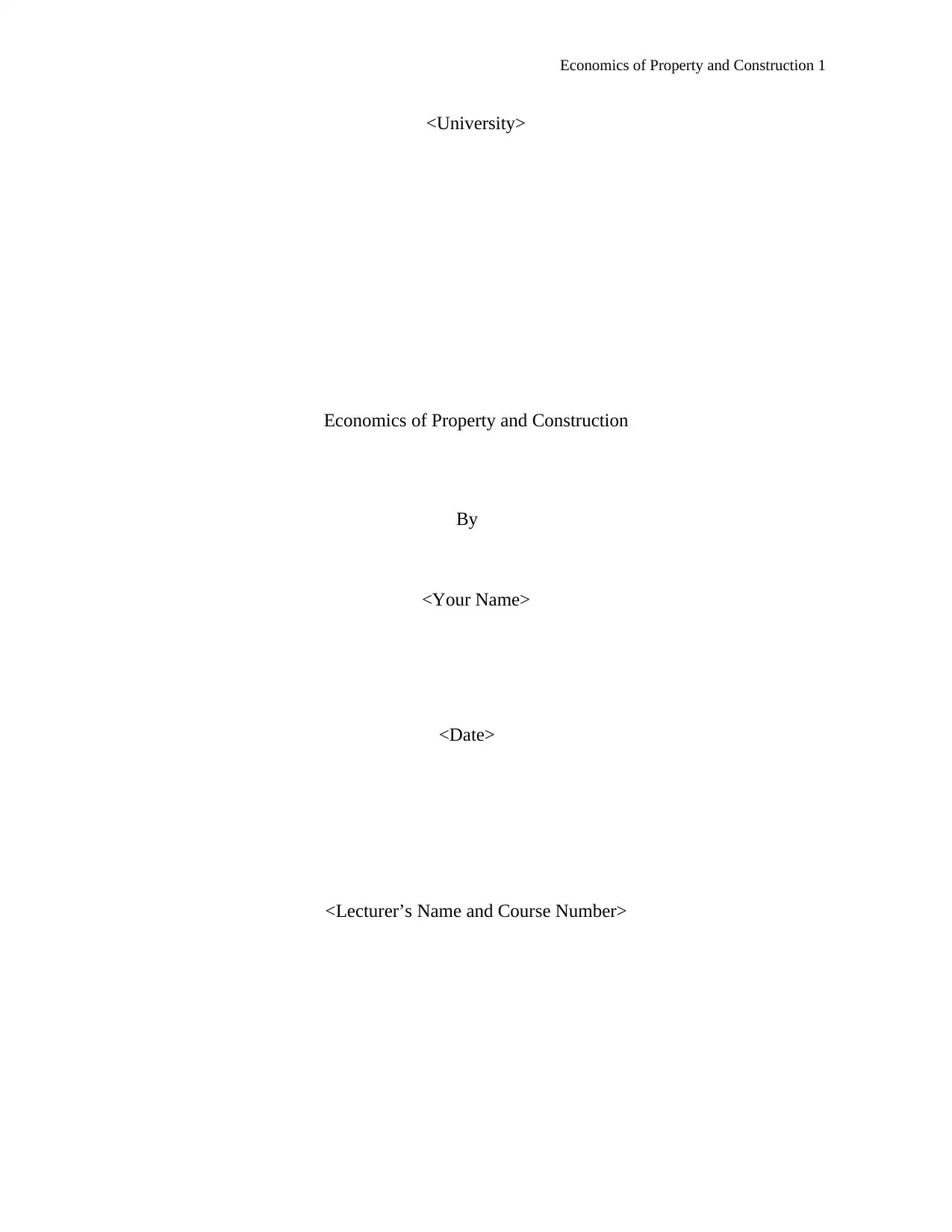
Economics of Property and Construction 1
<University>
Economics of Property and Construction
By
<Your Name>
<Date>
<Lecturer’s Name and Course Number>
<University>
Economics of Property and Construction
By
<Your Name>
<Date>
<Lecturer’s Name and Course Number>
Paraphrase This Document
Need a fresh take? Get an instant paraphrase of this document with our AI Paraphraser
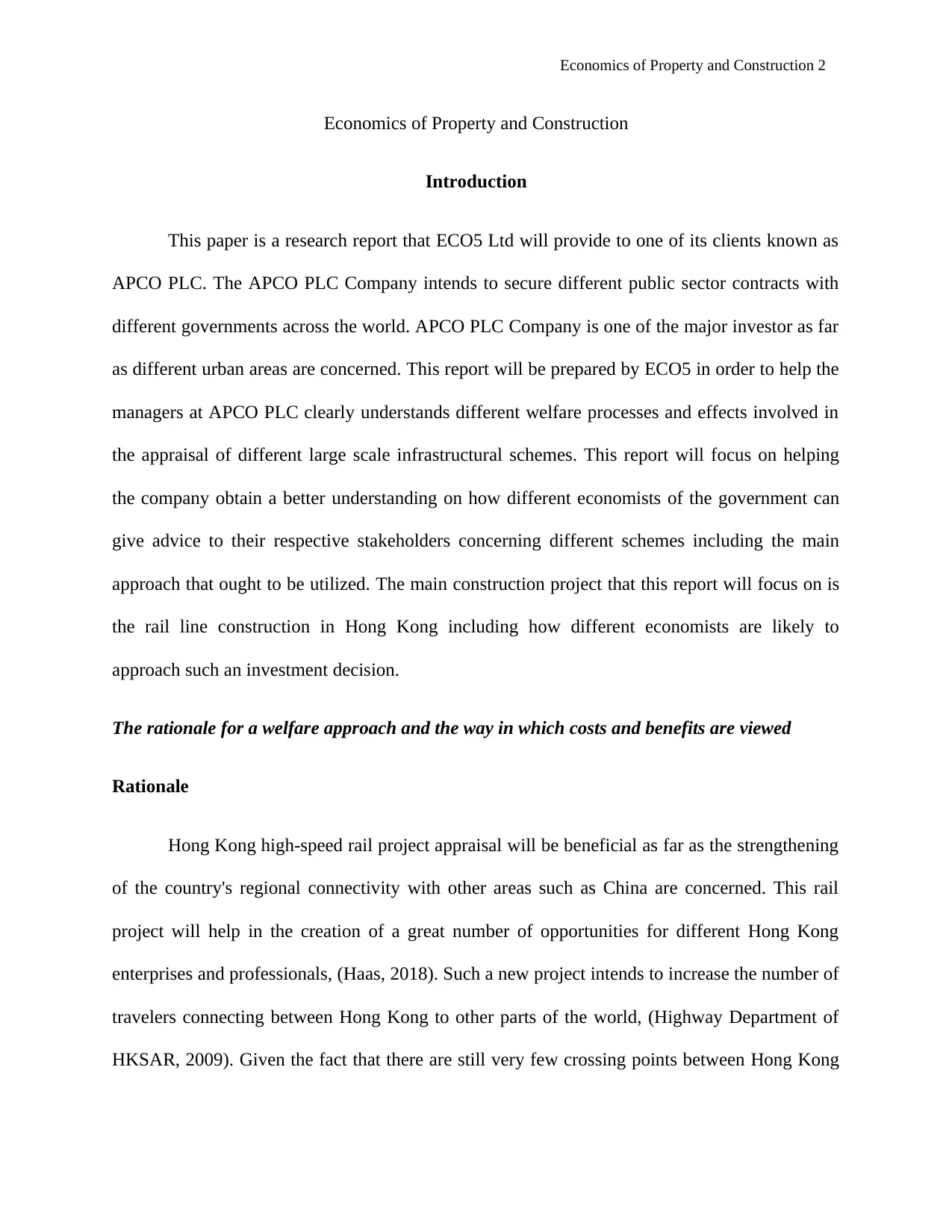
Economics of Property and Construction 2
Economics of Property and Construction
Introduction
This paper is a research report that ECO5 Ltd will provide to one of its clients known as
APCO PLC. The APCO PLC Company intends to secure different public sector contracts with
different governments across the world. APCO PLC Company is one of the major investor as far
as different urban areas are concerned. This report will be prepared by ECO5 in order to help the
managers at APCO PLC clearly understands different welfare processes and effects involved in
the appraisal of different large scale infrastructural schemes. This report will focus on helping
the company obtain a better understanding on how different economists of the government can
give advice to their respective stakeholders concerning different schemes including the main
approach that ought to be utilized. The main construction project that this report will focus on is
the rail line construction in Hong Kong including how different economists are likely to
approach such an investment decision.
The rationale for a welfare approach and the way in which costs and benefits are viewed
Rationale
Hong Kong high-speed rail project appraisal will be beneficial as far as the strengthening
of the country's regional connectivity with other areas such as China are concerned. This rail
project will help in the creation of a great number of opportunities for different Hong Kong
enterprises and professionals, (Haas, 2018). Such a new project intends to increase the number of
travelers connecting between Hong Kong to other parts of the world, (Highway Department of
HKSAR, 2009). Given the fact that there are still very few crossing points between Hong Kong
Economics of Property and Construction
Introduction
This paper is a research report that ECO5 Ltd will provide to one of its clients known as
APCO PLC. The APCO PLC Company intends to secure different public sector contracts with
different governments across the world. APCO PLC Company is one of the major investor as far
as different urban areas are concerned. This report will be prepared by ECO5 in order to help the
managers at APCO PLC clearly understands different welfare processes and effects involved in
the appraisal of different large scale infrastructural schemes. This report will focus on helping
the company obtain a better understanding on how different economists of the government can
give advice to their respective stakeholders concerning different schemes including the main
approach that ought to be utilized. The main construction project that this report will focus on is
the rail line construction in Hong Kong including how different economists are likely to
approach such an investment decision.
The rationale for a welfare approach and the way in which costs and benefits are viewed
Rationale
Hong Kong high-speed rail project appraisal will be beneficial as far as the strengthening
of the country's regional connectivity with other areas such as China are concerned. This rail
project will help in the creation of a great number of opportunities for different Hong Kong
enterprises and professionals, (Haas, 2018). Such a new project intends to increase the number of
travelers connecting between Hong Kong to other parts of the world, (Highway Department of
HKSAR, 2009). Given the fact that there are still very few crossing points between Hong Kong
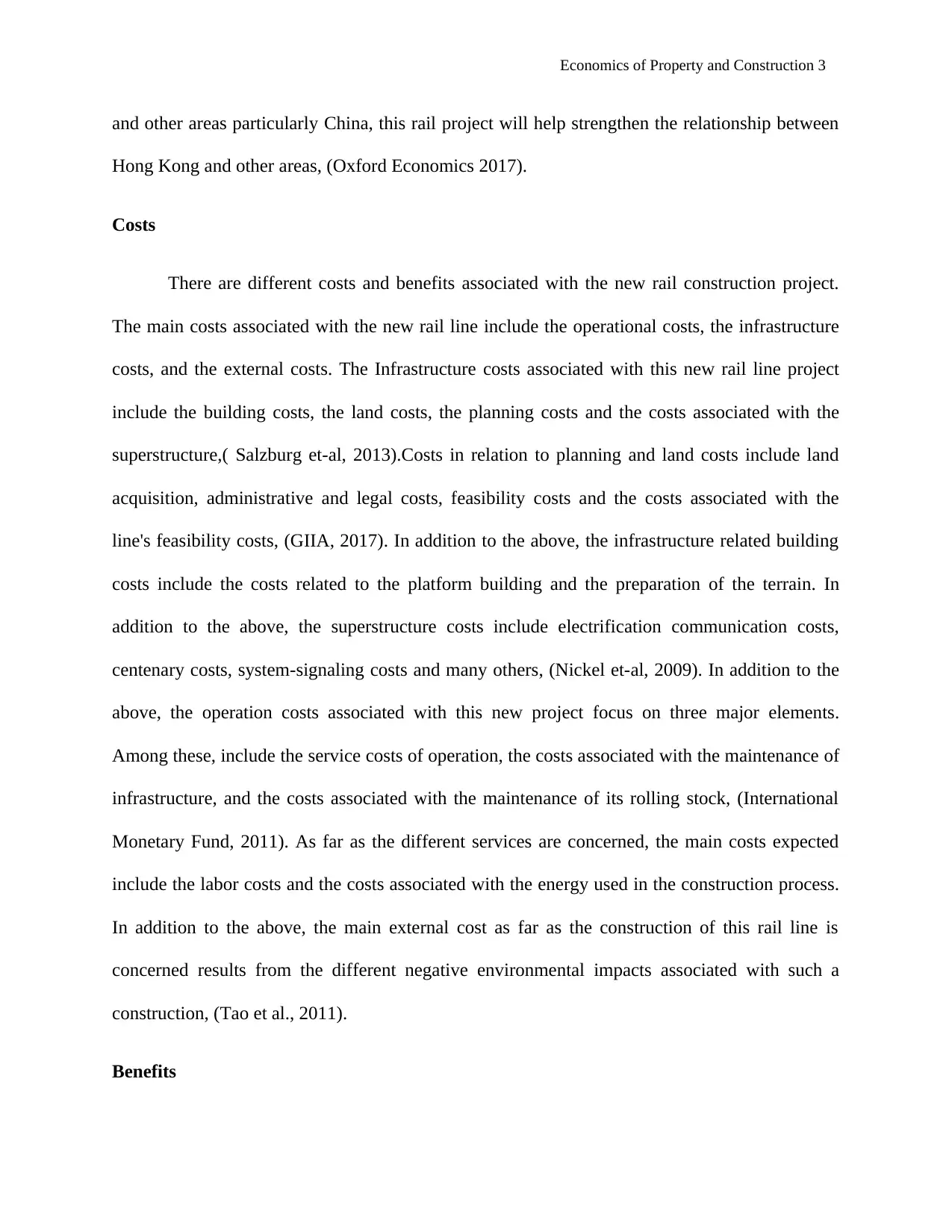
Economics of Property and Construction 3
and other areas particularly China, this rail project will help strengthen the relationship between
Hong Kong and other areas, (Oxford Economics 2017).
Costs
There are different costs and benefits associated with the new rail construction project.
The main costs associated with the new rail line include the operational costs, the infrastructure
costs, and the external costs. The Infrastructure costs associated with this new rail line project
include the building costs, the land costs, the planning costs and the costs associated with the
superstructure,( Salzburg et-al, 2013).Costs in relation to planning and land costs include land
acquisition, administrative and legal costs, feasibility costs and the costs associated with the
line's feasibility costs, (GIIA, 2017). In addition to the above, the infrastructure related building
costs include the costs related to the platform building and the preparation of the terrain. In
addition to the above, the superstructure costs include electrification communication costs,
centenary costs, system-signaling costs and many others, (Nickel et-al, 2009). In addition to the
above, the operation costs associated with this new project focus on three major elements.
Among these, include the service costs of operation, the costs associated with the maintenance of
infrastructure, and the costs associated with the maintenance of its rolling stock, (International
Monetary Fund, 2011). As far as the different services are concerned, the main costs expected
include the labor costs and the costs associated with the energy used in the construction process.
In addition to the above, the main external cost as far as the construction of this rail line is
concerned results from the different negative environmental impacts associated with such a
construction, (Tao et al., 2011).
Benefits
and other areas particularly China, this rail project will help strengthen the relationship between
Hong Kong and other areas, (Oxford Economics 2017).
Costs
There are different costs and benefits associated with the new rail construction project.
The main costs associated with the new rail line include the operational costs, the infrastructure
costs, and the external costs. The Infrastructure costs associated with this new rail line project
include the building costs, the land costs, the planning costs and the costs associated with the
superstructure,( Salzburg et-al, 2013).Costs in relation to planning and land costs include land
acquisition, administrative and legal costs, feasibility costs and the costs associated with the
line's feasibility costs, (GIIA, 2017). In addition to the above, the infrastructure related building
costs include the costs related to the platform building and the preparation of the terrain. In
addition to the above, the superstructure costs include electrification communication costs,
centenary costs, system-signaling costs and many others, (Nickel et-al, 2009). In addition to the
above, the operation costs associated with this new project focus on three major elements.
Among these, include the service costs of operation, the costs associated with the maintenance of
infrastructure, and the costs associated with the maintenance of its rolling stock, (International
Monetary Fund, 2011). As far as the different services are concerned, the main costs expected
include the labor costs and the costs associated with the energy used in the construction process.
In addition to the above, the main external cost as far as the construction of this rail line is
concerned results from the different negative environmental impacts associated with such a
construction, (Tao et al., 2011).
Benefits
⊘ This is a preview!⊘
Do you want full access?
Subscribe today to unlock all pages.

Trusted by 1+ million students worldwide
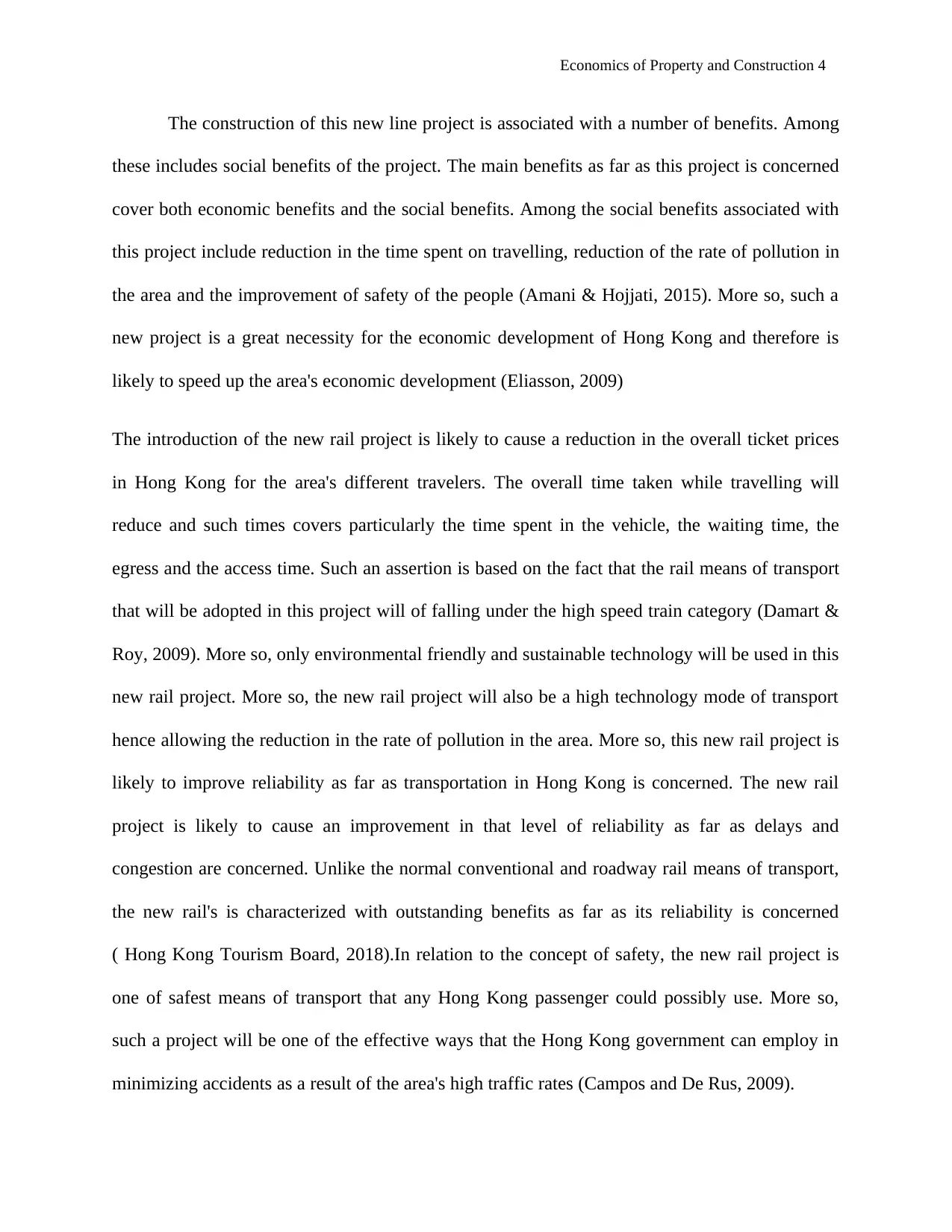
Economics of Property and Construction 4
The construction of this new line project is associated with a number of benefits. Among
these includes social benefits of the project. The main benefits as far as this project is concerned
cover both economic benefits and the social benefits. Among the social benefits associated with
this project include reduction in the time spent on travelling, reduction of the rate of pollution in
the area and the improvement of safety of the people (Amani & Hojjati, 2015). More so, such a
new project is a great necessity for the economic development of Hong Kong and therefore is
likely to speed up the area's economic development (Eliasson, 2009)
The introduction of the new rail project is likely to cause a reduction in the overall ticket prices
in Hong Kong for the area's different travelers. The overall time taken while travelling will
reduce and such times covers particularly the time spent in the vehicle, the waiting time, the
egress and the access time. Such an assertion is based on the fact that the rail means of transport
that will be adopted in this project will of falling under the high speed train category (Damart &
Roy, 2009). More so, only environmental friendly and sustainable technology will be used in this
new rail project. More so, the new rail project will also be a high technology mode of transport
hence allowing the reduction in the rate of pollution in the area. More so, this new rail project is
likely to improve reliability as far as transportation in Hong Kong is concerned. The new rail
project is likely to cause an improvement in that level of reliability as far as delays and
congestion are concerned. Unlike the normal conventional and roadway rail means of transport,
the new rail's is characterized with outstanding benefits as far as its reliability is concerned
( Hong Kong Tourism Board, 2018).In relation to the concept of safety, the new rail project is
one of safest means of transport that any Hong Kong passenger could possibly use. More so,
such a project will be one of the effective ways that the Hong Kong government can employ in
minimizing accidents as a result of the area's high traffic rates (Campos and De Rus, 2009).
The construction of this new line project is associated with a number of benefits. Among
these includes social benefits of the project. The main benefits as far as this project is concerned
cover both economic benefits and the social benefits. Among the social benefits associated with
this project include reduction in the time spent on travelling, reduction of the rate of pollution in
the area and the improvement of safety of the people (Amani & Hojjati, 2015). More so, such a
new project is a great necessity for the economic development of Hong Kong and therefore is
likely to speed up the area's economic development (Eliasson, 2009)
The introduction of the new rail project is likely to cause a reduction in the overall ticket prices
in Hong Kong for the area's different travelers. The overall time taken while travelling will
reduce and such times covers particularly the time spent in the vehicle, the waiting time, the
egress and the access time. Such an assertion is based on the fact that the rail means of transport
that will be adopted in this project will of falling under the high speed train category (Damart &
Roy, 2009). More so, only environmental friendly and sustainable technology will be used in this
new rail project. More so, the new rail project will also be a high technology mode of transport
hence allowing the reduction in the rate of pollution in the area. More so, this new rail project is
likely to improve reliability as far as transportation in Hong Kong is concerned. The new rail
project is likely to cause an improvement in that level of reliability as far as delays and
congestion are concerned. Unlike the normal conventional and roadway rail means of transport,
the new rail's is characterized with outstanding benefits as far as its reliability is concerned
( Hong Kong Tourism Board, 2018).In relation to the concept of safety, the new rail project is
one of safest means of transport that any Hong Kong passenger could possibly use. More so,
such a project will be one of the effective ways that the Hong Kong government can employ in
minimizing accidents as a result of the area's high traffic rates (Campos and De Rus, 2009).
Paraphrase This Document
Need a fresh take? Get an instant paraphrase of this document with our AI Paraphraser
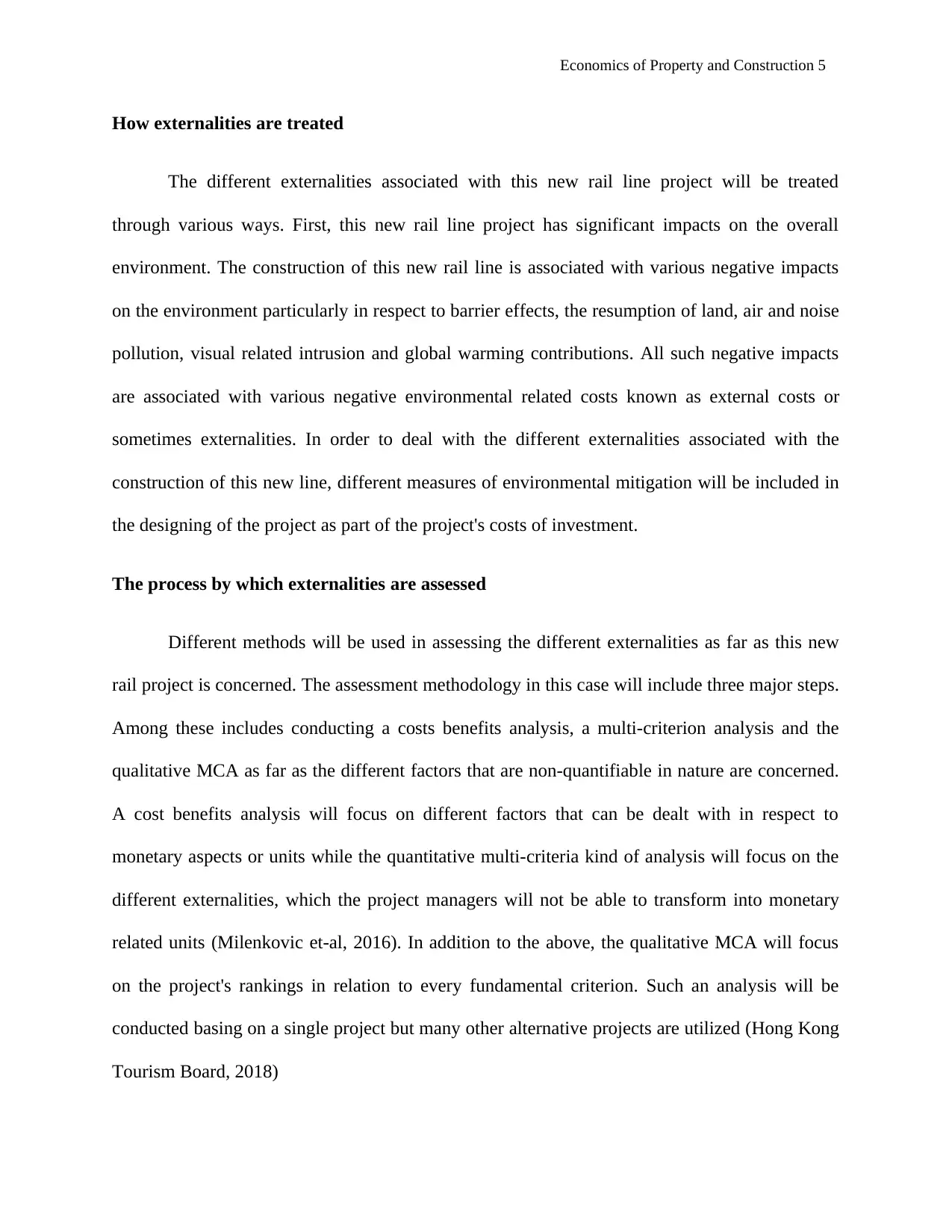
Economics of Property and Construction 5
How externalities are treated
The different externalities associated with this new rail line project will be treated
through various ways. First, this new rail line project has significant impacts on the overall
environment. The construction of this new rail line is associated with various negative impacts
on the environment particularly in respect to barrier effects, the resumption of land, air and noise
pollution, visual related intrusion and global warming contributions. All such negative impacts
are associated with various negative environmental related costs known as external costs or
sometimes externalities. In order to deal with the different externalities associated with the
construction of this new line, different measures of environmental mitigation will be included in
the designing of the project as part of the project's costs of investment.
The process by which externalities are assessed
Different methods will be used in assessing the different externalities as far as this new
rail project is concerned. The assessment methodology in this case will include three major steps.
Among these includes conducting a costs benefits analysis, a multi-criterion analysis and the
qualitative MCA as far as the different factors that are non-quantifiable in nature are concerned.
A cost benefits analysis will focus on different factors that can be dealt with in respect to
monetary aspects or units while the quantitative multi-criteria kind of analysis will focus on the
different externalities, which the project managers will not be able to transform into monetary
related units (Milenkovic et-al, 2016). In addition to the above, the qualitative MCA will focus
on the project's rankings in relation to every fundamental criterion. Such an analysis will be
conducted basing on a single project but many other alternative projects are utilized (Hong Kong
Tourism Board, 2018)
How externalities are treated
The different externalities associated with this new rail line project will be treated
through various ways. First, this new rail line project has significant impacts on the overall
environment. The construction of this new rail line is associated with various negative impacts
on the environment particularly in respect to barrier effects, the resumption of land, air and noise
pollution, visual related intrusion and global warming contributions. All such negative impacts
are associated with various negative environmental related costs known as external costs or
sometimes externalities. In order to deal with the different externalities associated with the
construction of this new line, different measures of environmental mitigation will be included in
the designing of the project as part of the project's costs of investment.
The process by which externalities are assessed
Different methods will be used in assessing the different externalities as far as this new
rail project is concerned. The assessment methodology in this case will include three major steps.
Among these includes conducting a costs benefits analysis, a multi-criterion analysis and the
qualitative MCA as far as the different factors that are non-quantifiable in nature are concerned.
A cost benefits analysis will focus on different factors that can be dealt with in respect to
monetary aspects or units while the quantitative multi-criteria kind of analysis will focus on the
different externalities, which the project managers will not be able to transform into monetary
related units (Milenkovic et-al, 2016). In addition to the above, the qualitative MCA will focus
on the project's rankings in relation to every fundamental criterion. Such an analysis will be
conducted basing on a single project but many other alternative projects are utilized (Hong Kong
Tourism Board, 2018)
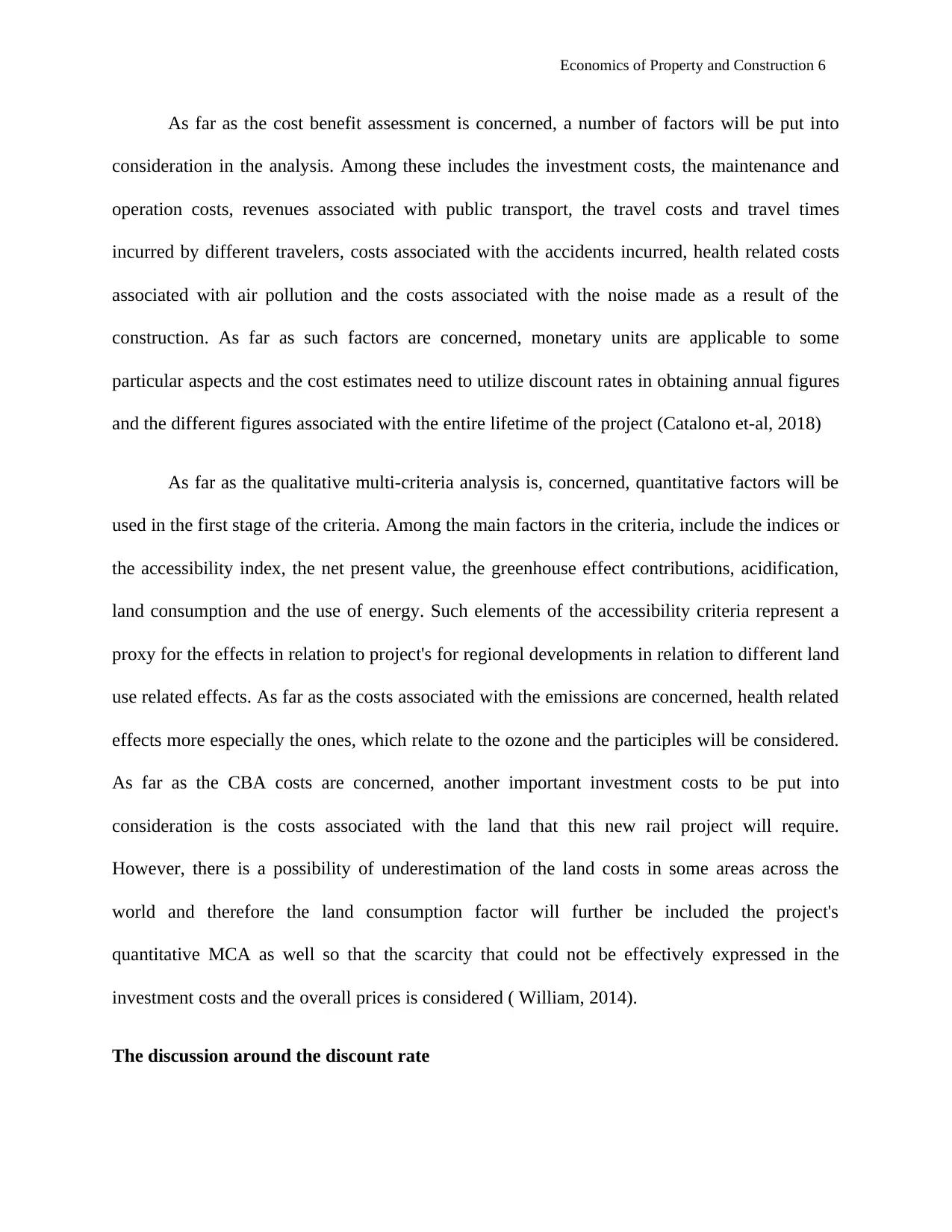
Economics of Property and Construction 6
As far as the cost benefit assessment is concerned, a number of factors will be put into
consideration in the analysis. Among these includes the investment costs, the maintenance and
operation costs, revenues associated with public transport, the travel costs and travel times
incurred by different travelers, costs associated with the accidents incurred, health related costs
associated with air pollution and the costs associated with the noise made as a result of the
construction. As far as such factors are concerned, monetary units are applicable to some
particular aspects and the cost estimates need to utilize discount rates in obtaining annual figures
and the different figures associated with the entire lifetime of the project (Catalono et-al, 2018)
As far as the qualitative multi-criteria analysis is, concerned, quantitative factors will be
used in the first stage of the criteria. Among the main factors in the criteria, include the indices or
the accessibility index, the net present value, the greenhouse effect contributions, acidification,
land consumption and the use of energy. Such elements of the accessibility criteria represent a
proxy for the effects in relation to project's for regional developments in relation to different land
use related effects. As far as the costs associated with the emissions are concerned, health related
effects more especially the ones, which relate to the ozone and the participles will be considered.
As far as the CBA costs are concerned, another important investment costs to be put into
consideration is the costs associated with the land that this new rail project will require.
However, there is a possibility of underestimation of the land costs in some areas across the
world and therefore the land consumption factor will further be included the project's
quantitative MCA as well so that the scarcity that could not be effectively expressed in the
investment costs and the overall prices is considered ( William, 2014).
The discussion around the discount rate
As far as the cost benefit assessment is concerned, a number of factors will be put into
consideration in the analysis. Among these includes the investment costs, the maintenance and
operation costs, revenues associated with public transport, the travel costs and travel times
incurred by different travelers, costs associated with the accidents incurred, health related costs
associated with air pollution and the costs associated with the noise made as a result of the
construction. As far as such factors are concerned, monetary units are applicable to some
particular aspects and the cost estimates need to utilize discount rates in obtaining annual figures
and the different figures associated with the entire lifetime of the project (Catalono et-al, 2018)
As far as the qualitative multi-criteria analysis is, concerned, quantitative factors will be
used in the first stage of the criteria. Among the main factors in the criteria, include the indices or
the accessibility index, the net present value, the greenhouse effect contributions, acidification,
land consumption and the use of energy. Such elements of the accessibility criteria represent a
proxy for the effects in relation to project's for regional developments in relation to different land
use related effects. As far as the costs associated with the emissions are concerned, health related
effects more especially the ones, which relate to the ozone and the participles will be considered.
As far as the CBA costs are concerned, another important investment costs to be put into
consideration is the costs associated with the land that this new rail project will require.
However, there is a possibility of underestimation of the land costs in some areas across the
world and therefore the land consumption factor will further be included the project's
quantitative MCA as well so that the scarcity that could not be effectively expressed in the
investment costs and the overall prices is considered ( William, 2014).
The discussion around the discount rate
⊘ This is a preview!⊘
Do you want full access?
Subscribe today to unlock all pages.

Trusted by 1+ million students worldwide
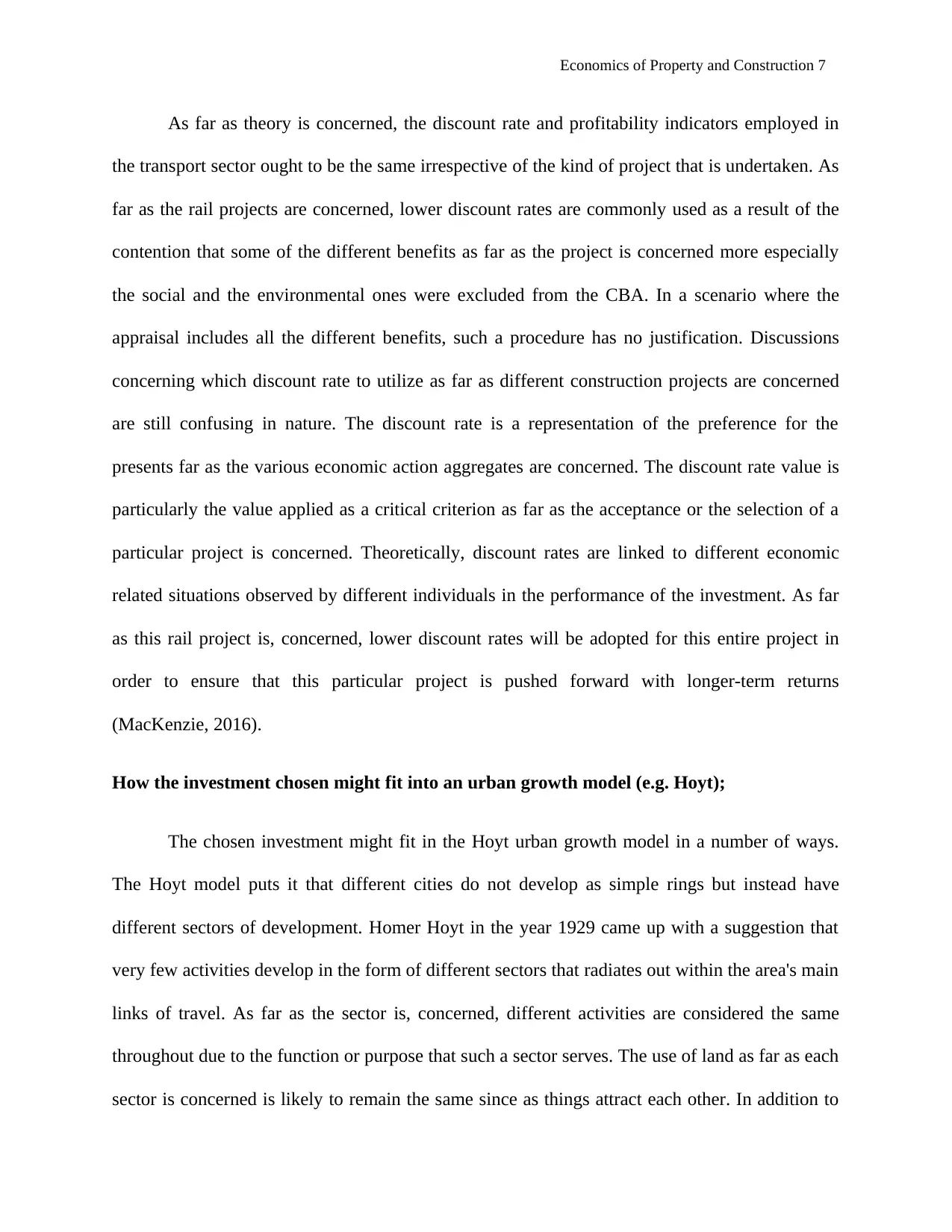
Economics of Property and Construction 7
As far as theory is concerned, the discount rate and profitability indicators employed in
the transport sector ought to be the same irrespective of the kind of project that is undertaken. As
far as the rail projects are concerned, lower discount rates are commonly used as a result of the
contention that some of the different benefits as far as the project is concerned more especially
the social and the environmental ones were excluded from the CBA. In a scenario where the
appraisal includes all the different benefits, such a procedure has no justification. Discussions
concerning which discount rate to utilize as far as different construction projects are concerned
are still confusing in nature. The discount rate is a representation of the preference for the
presents far as the various economic action aggregates are concerned. The discount rate value is
particularly the value applied as a critical criterion as far as the acceptance or the selection of a
particular project is concerned. Theoretically, discount rates are linked to different economic
related situations observed by different individuals in the performance of the investment. As far
as this rail project is, concerned, lower discount rates will be adopted for this entire project in
order to ensure that this particular project is pushed forward with longer-term returns
(MacKenzie, 2016).
How the investment chosen might fit into an urban growth model (e.g. Hoyt);
The chosen investment might fit in the Hoyt urban growth model in a number of ways.
The Hoyt model puts it that different cities do not develop as simple rings but instead have
different sectors of development. Homer Hoyt in the year 1929 came up with a suggestion that
very few activities develop in the form of different sectors that radiates out within the area's main
links of travel. As far as the sector is, concerned, different activities are considered the same
throughout due to the function or purpose that such a sector serves. The use of land as far as each
sector is concerned is likely to remain the same since as things attract each other. In addition to
As far as theory is concerned, the discount rate and profitability indicators employed in
the transport sector ought to be the same irrespective of the kind of project that is undertaken. As
far as the rail projects are concerned, lower discount rates are commonly used as a result of the
contention that some of the different benefits as far as the project is concerned more especially
the social and the environmental ones were excluded from the CBA. In a scenario where the
appraisal includes all the different benefits, such a procedure has no justification. Discussions
concerning which discount rate to utilize as far as different construction projects are concerned
are still confusing in nature. The discount rate is a representation of the preference for the
presents far as the various economic action aggregates are concerned. The discount rate value is
particularly the value applied as a critical criterion as far as the acceptance or the selection of a
particular project is concerned. Theoretically, discount rates are linked to different economic
related situations observed by different individuals in the performance of the investment. As far
as this rail project is, concerned, lower discount rates will be adopted for this entire project in
order to ensure that this particular project is pushed forward with longer-term returns
(MacKenzie, 2016).
How the investment chosen might fit into an urban growth model (e.g. Hoyt);
The chosen investment might fit in the Hoyt urban growth model in a number of ways.
The Hoyt model puts it that different cities do not develop as simple rings but instead have
different sectors of development. Homer Hoyt in the year 1929 came up with a suggestion that
very few activities develop in the form of different sectors that radiates out within the area's main
links of travel. As far as the sector is, concerned, different activities are considered the same
throughout due to the function or purpose that such a sector serves. The use of land as far as each
sector is concerned is likely to remain the same since as things attract each other. In addition to
Paraphrase This Document
Need a fresh take? Get an instant paraphrase of this document with our AI Paraphraser
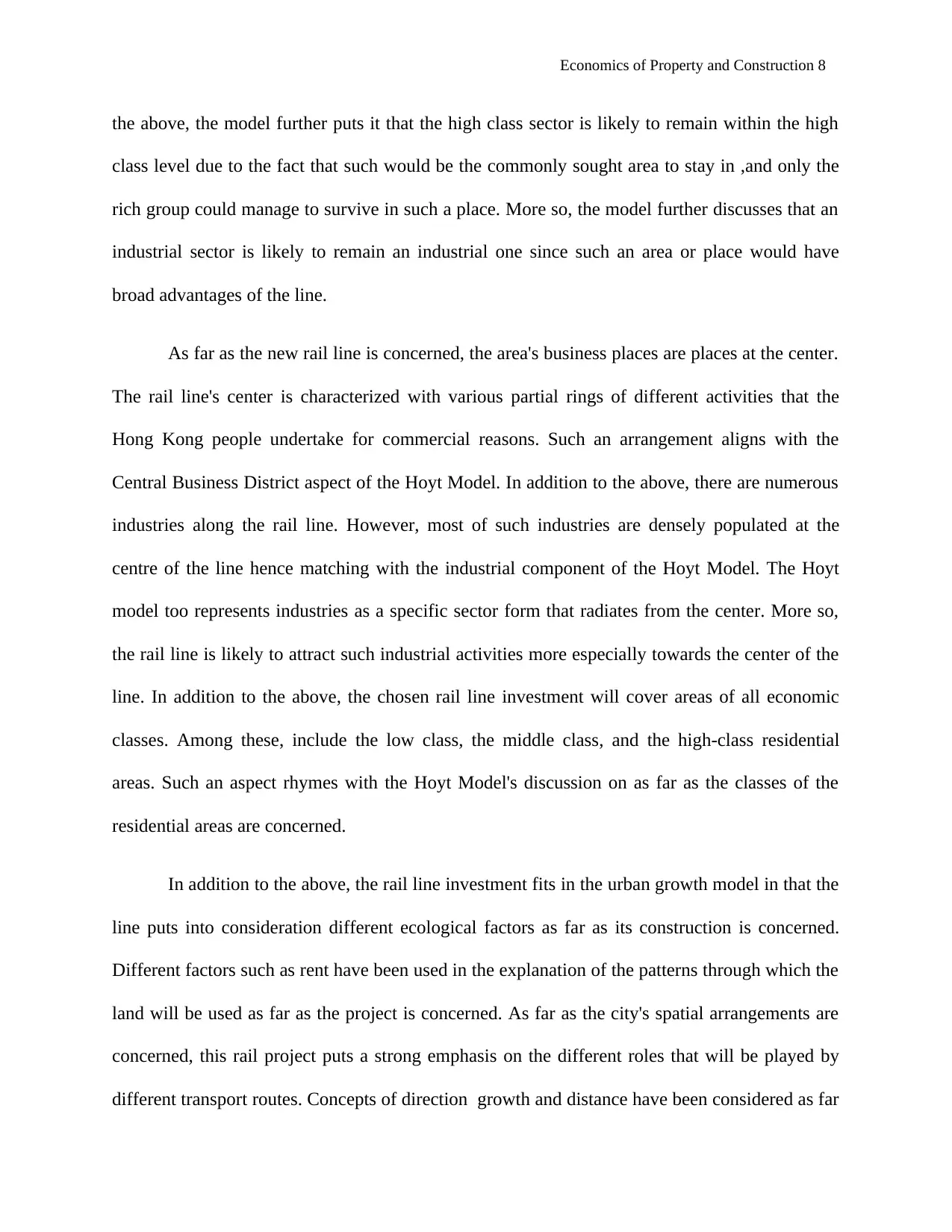
Economics of Property and Construction 8
the above, the model further puts it that the high class sector is likely to remain within the high
class level due to the fact that such would be the commonly sought area to stay in ,and only the
rich group could manage to survive in such a place. More so, the model further discusses that an
industrial sector is likely to remain an industrial one since such an area or place would have
broad advantages of the line.
As far as the new rail line is concerned, the area's business places are places at the center.
The rail line's center is characterized with various partial rings of different activities that the
Hong Kong people undertake for commercial reasons. Such an arrangement aligns with the
Central Business District aspect of the Hoyt Model. In addition to the above, there are numerous
industries along the rail line. However, most of such industries are densely populated at the
centre of the line hence matching with the industrial component of the Hoyt Model. The Hoyt
model too represents industries as a specific sector form that radiates from the center. More so,
the rail line is likely to attract such industrial activities more especially towards the center of the
line. In addition to the above, the chosen rail line investment will cover areas of all economic
classes. Among these, include the low class, the middle class, and the high-class residential
areas. Such an aspect rhymes with the Hoyt Model's discussion on as far as the classes of the
residential areas are concerned.
In addition to the above, the rail line investment fits in the urban growth model in that the
line puts into consideration different ecological factors as far as its construction is concerned.
Different factors such as rent have been used in the explanation of the patterns through which the
land will be used as far as the project is concerned. As far as the city's spatial arrangements are
concerned, this rail project puts a strong emphasis on the different roles that will be played by
different transport routes. Concepts of direction growth and distance have been considered as far
the above, the model further puts it that the high class sector is likely to remain within the high
class level due to the fact that such would be the commonly sought area to stay in ,and only the
rich group could manage to survive in such a place. More so, the model further discusses that an
industrial sector is likely to remain an industrial one since such an area or place would have
broad advantages of the line.
As far as the new rail line is concerned, the area's business places are places at the center.
The rail line's center is characterized with various partial rings of different activities that the
Hong Kong people undertake for commercial reasons. Such an arrangement aligns with the
Central Business District aspect of the Hoyt Model. In addition to the above, there are numerous
industries along the rail line. However, most of such industries are densely populated at the
centre of the line hence matching with the industrial component of the Hoyt Model. The Hoyt
model too represents industries as a specific sector form that radiates from the center. More so,
the rail line is likely to attract such industrial activities more especially towards the center of the
line. In addition to the above, the chosen rail line investment will cover areas of all economic
classes. Among these, include the low class, the middle class, and the high-class residential
areas. Such an aspect rhymes with the Hoyt Model's discussion on as far as the classes of the
residential areas are concerned.
In addition to the above, the rail line investment fits in the urban growth model in that the
line puts into consideration different ecological factors as far as its construction is concerned.
Different factors such as rent have been used in the explanation of the patterns through which the
land will be used as far as the project is concerned. As far as the city's spatial arrangements are
concerned, this rail project puts a strong emphasis on the different roles that will be played by
different transport routes. Concepts of direction growth and distance have been considered as far
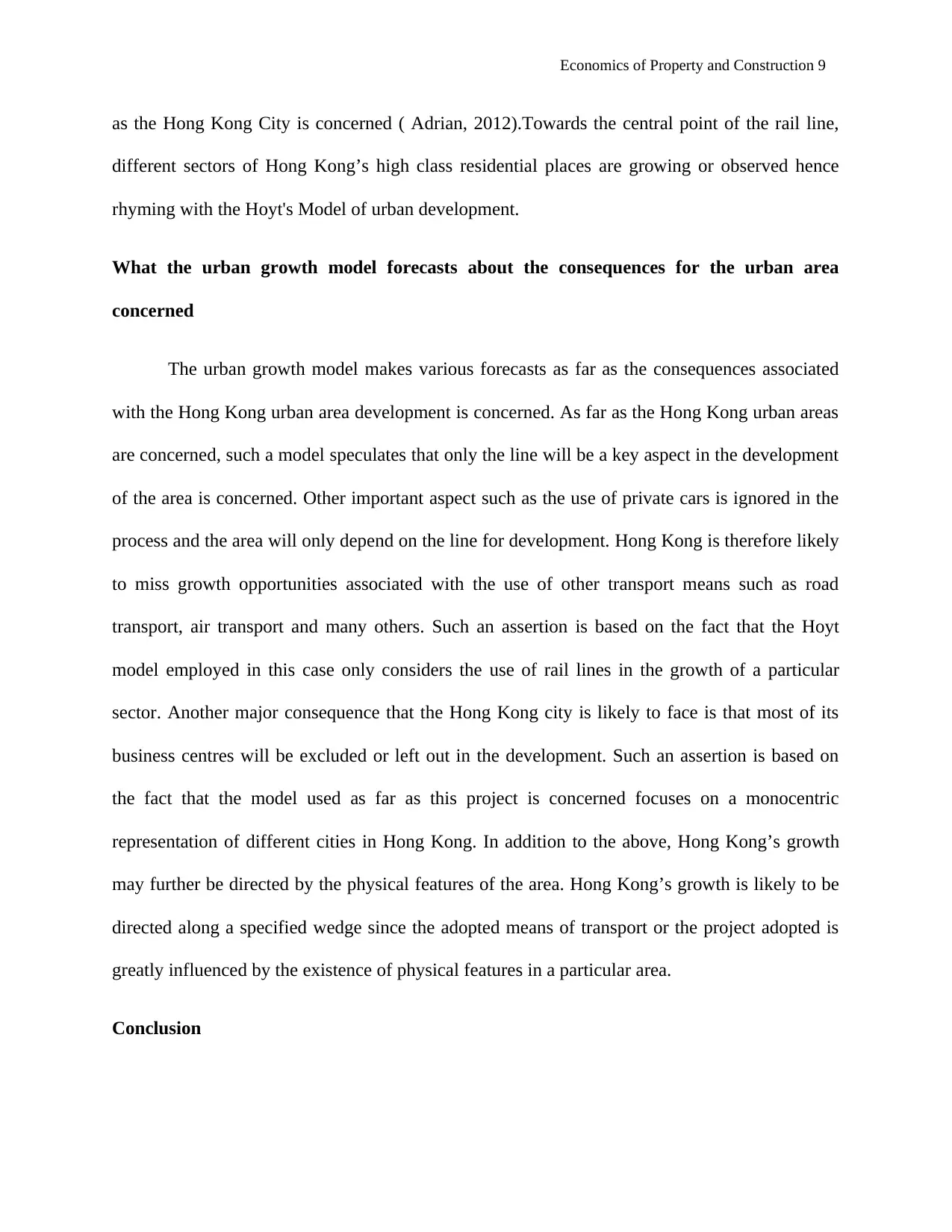
Economics of Property and Construction 9
as the Hong Kong City is concerned ( Adrian, 2012).Towards the central point of the rail line,
different sectors of Hong Kong’s high class residential places are growing or observed hence
rhyming with the Hoyt's Model of urban development.
What the urban growth model forecasts about the consequences for the urban area
concerned
The urban growth model makes various forecasts as far as the consequences associated
with the Hong Kong urban area development is concerned. As far as the Hong Kong urban areas
are concerned, such a model speculates that only the line will be a key aspect in the development
of the area is concerned. Other important aspect such as the use of private cars is ignored in the
process and the area will only depend on the line for development. Hong Kong is therefore likely
to miss growth opportunities associated with the use of other transport means such as road
transport, air transport and many others. Such an assertion is based on the fact that the Hoyt
model employed in this case only considers the use of rail lines in the growth of a particular
sector. Another major consequence that the Hong Kong city is likely to face is that most of its
business centres will be excluded or left out in the development. Such an assertion is based on
the fact that the model used as far as this project is concerned focuses on a monocentric
representation of different cities in Hong Kong. In addition to the above, Hong Kong’s growth
may further be directed by the physical features of the area. Hong Kong’s growth is likely to be
directed along a specified wedge since the adopted means of transport or the project adopted is
greatly influenced by the existence of physical features in a particular area.
Conclusion
as the Hong Kong City is concerned ( Adrian, 2012).Towards the central point of the rail line,
different sectors of Hong Kong’s high class residential places are growing or observed hence
rhyming with the Hoyt's Model of urban development.
What the urban growth model forecasts about the consequences for the urban area
concerned
The urban growth model makes various forecasts as far as the consequences associated
with the Hong Kong urban area development is concerned. As far as the Hong Kong urban areas
are concerned, such a model speculates that only the line will be a key aspect in the development
of the area is concerned. Other important aspect such as the use of private cars is ignored in the
process and the area will only depend on the line for development. Hong Kong is therefore likely
to miss growth opportunities associated with the use of other transport means such as road
transport, air transport and many others. Such an assertion is based on the fact that the Hoyt
model employed in this case only considers the use of rail lines in the growth of a particular
sector. Another major consequence that the Hong Kong city is likely to face is that most of its
business centres will be excluded or left out in the development. Such an assertion is based on
the fact that the model used as far as this project is concerned focuses on a monocentric
representation of different cities in Hong Kong. In addition to the above, Hong Kong’s growth
may further be directed by the physical features of the area. Hong Kong’s growth is likely to be
directed along a specified wedge since the adopted means of transport or the project adopted is
greatly influenced by the existence of physical features in a particular area.
Conclusion
⊘ This is a preview!⊘
Do you want full access?
Subscribe today to unlock all pages.

Trusted by 1+ million students worldwide
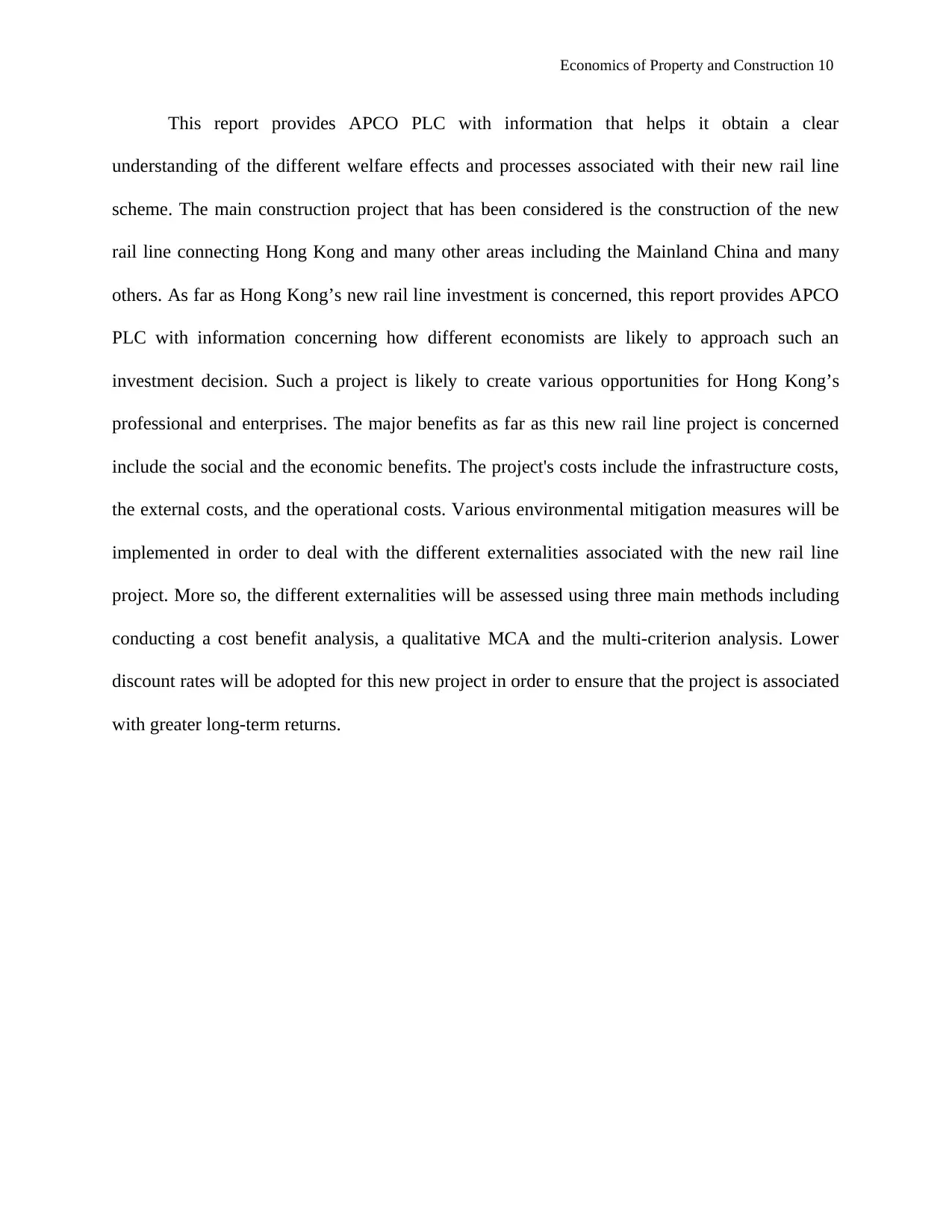
Economics of Property and Construction 10
This report provides APCO PLC with information that helps it obtain a clear
understanding of the different welfare effects and processes associated with their new rail line
scheme. The main construction project that has been considered is the construction of the new
rail line connecting Hong Kong and many other areas including the Mainland China and many
others. As far as Hong Kong’s new rail line investment is concerned, this report provides APCO
PLC with information concerning how different economists are likely to approach such an
investment decision. Such a project is likely to create various opportunities for Hong Kong’s
professional and enterprises. The major benefits as far as this new rail line project is concerned
include the social and the economic benefits. The project's costs include the infrastructure costs,
the external costs, and the operational costs. Various environmental mitigation measures will be
implemented in order to deal with the different externalities associated with the new rail line
project. More so, the different externalities will be assessed using three main methods including
conducting a cost benefit analysis, a qualitative MCA and the multi-criterion analysis. Lower
discount rates will be adopted for this new project in order to ensure that the project is associated
with greater long-term returns.
This report provides APCO PLC with information that helps it obtain a clear
understanding of the different welfare effects and processes associated with their new rail line
scheme. The main construction project that has been considered is the construction of the new
rail line connecting Hong Kong and many other areas including the Mainland China and many
others. As far as Hong Kong’s new rail line investment is concerned, this report provides APCO
PLC with information concerning how different economists are likely to approach such an
investment decision. Such a project is likely to create various opportunities for Hong Kong’s
professional and enterprises. The major benefits as far as this new rail line project is concerned
include the social and the economic benefits. The project's costs include the infrastructure costs,
the external costs, and the operational costs. Various environmental mitigation measures will be
implemented in order to deal with the different externalities associated with the new rail line
project. More so, the different externalities will be assessed using three main methods including
conducting a cost benefit analysis, a qualitative MCA and the multi-criterion analysis. Lower
discount rates will be adopted for this new project in order to ensure that the project is associated
with greater long-term returns.
Paraphrase This Document
Need a fresh take? Get an instant paraphrase of this document with our AI Paraphraser

Economics of Property and Construction 11
Reference List
Adrian S. 2012. "Predicting the Contact Wire Wear of a Railway System Using ANN". Rail
Knowledge Bank. [Accessed 11 June 2019]
Amani N & Hojjati M. 2015. Engineering System in Implementing Building Installation
Management Process. International Journal of Applied Engineering Research 10(2):3981-3993
Campos, J. and De Rus, G. 2009. Some stylized facts about high speed rail. A review of HSR
experiences around the world. Transp Policy, 16, 19-28.
Catalono G, Daraio C,Diana M, Matteucci G. 2018. Efficiency, effectiveness, and impacts
assessment in the rail transport sector: A state-of-the-art critical analysis of current research.
Int Trans Oper Res
Damart, S. and Roy, B. 2009. The uses of cost-benefit analysis in public transportation decision-
making in France. Transp Policy, 16, 200-212
Eliasson, J. 2009. A cost–benefit analysis of the Stockholm congestion charging system.
Transportation Res Part A, 43, 468-480
GIIA. 2017. ‘Global infrastructure Investment: The role of private capital in the delivery of
essential assets and services’ [online]. Available at: www.pwc.com/gx/en/industries/capital-
projectsinfrastructure/publications/global-infrastructure-investment.html [Accessed 11 June
2019]
Haas B. 2018. "Hong Kong cedes part of rail station to China in secretive ceremony". The
Guardian. [Accessed 11 June 2019]
Reference List
Adrian S. 2012. "Predicting the Contact Wire Wear of a Railway System Using ANN". Rail
Knowledge Bank. [Accessed 11 June 2019]
Amani N & Hojjati M. 2015. Engineering System in Implementing Building Installation
Management Process. International Journal of Applied Engineering Research 10(2):3981-3993
Campos, J. and De Rus, G. 2009. Some stylized facts about high speed rail. A review of HSR
experiences around the world. Transp Policy, 16, 19-28.
Catalono G, Daraio C,Diana M, Matteucci G. 2018. Efficiency, effectiveness, and impacts
assessment in the rail transport sector: A state-of-the-art critical analysis of current research.
Int Trans Oper Res
Damart, S. and Roy, B. 2009. The uses of cost-benefit analysis in public transportation decision-
making in France. Transp Policy, 16, 200-212
Eliasson, J. 2009. A cost–benefit analysis of the Stockholm congestion charging system.
Transportation Res Part A, 43, 468-480
GIIA. 2017. ‘Global infrastructure Investment: The role of private capital in the delivery of
essential assets and services’ [online]. Available at: www.pwc.com/gx/en/industries/capital-
projectsinfrastructure/publications/global-infrastructure-investment.html [Accessed 11 June
2019]
Haas B. 2018. "Hong Kong cedes part of rail station to China in secretive ceremony". The
Guardian. [Accessed 11 June 2019]
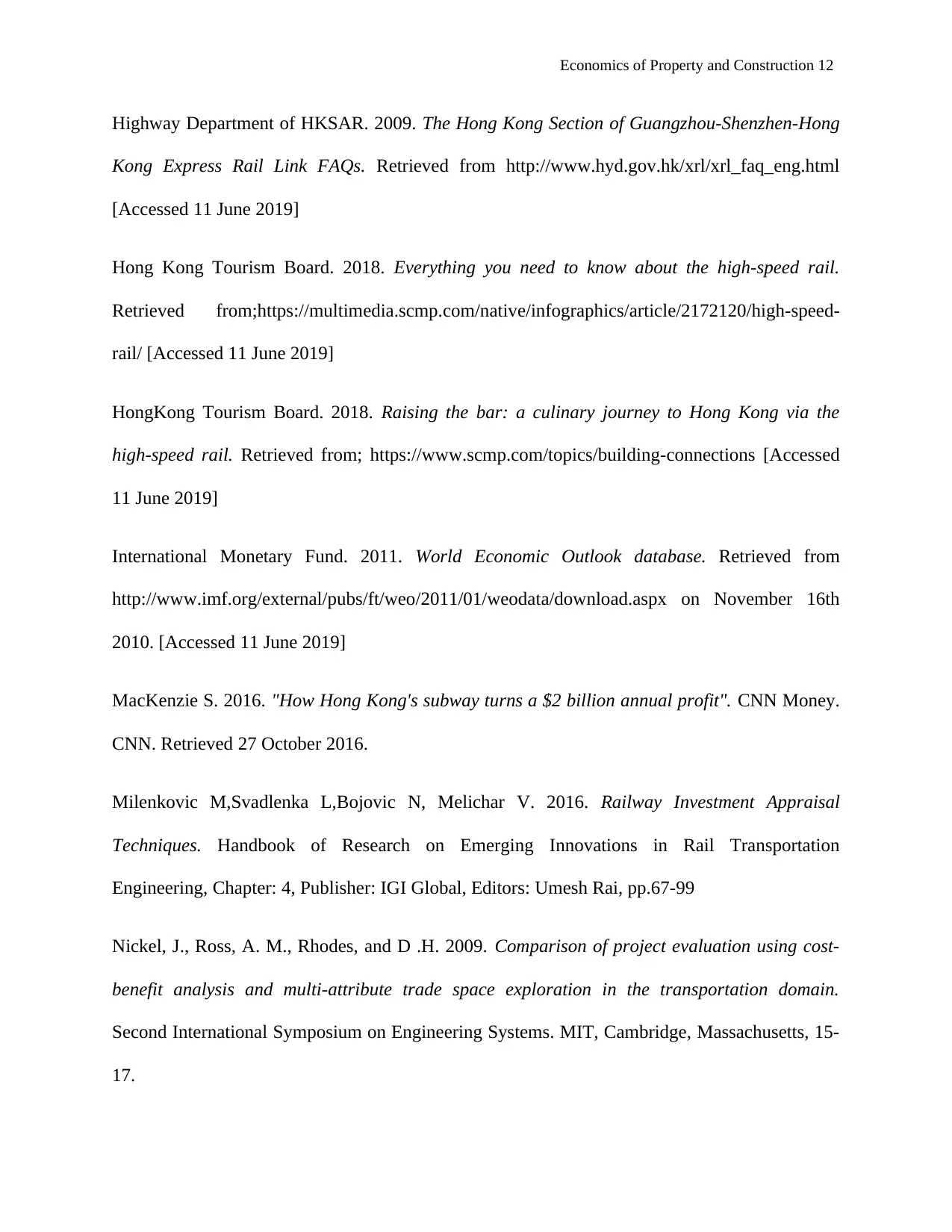
Economics of Property and Construction 12
Highway Department of HKSAR. 2009. The Hong Kong Section of Guangzhou-Shenzhen-Hong
Kong Express Rail Link FAQs. Retrieved from http://www.hyd.gov.hk/xrl/xrl_faq_eng.html
[Accessed 11 June 2019]
Hong Kong Tourism Board. 2018. Everything you need to know about the high-speed rail.
Retrieved from;https://multimedia.scmp.com/native/infographics/article/2172120/high-speed-
rail/ [Accessed 11 June 2019]
HongKong Tourism Board. 2018. Raising the bar: a culinary journey to Hong Kong via the
high-speed rail. Retrieved from; https://www.scmp.com/topics/building-connections [Accessed
11 June 2019]
International Monetary Fund. 2011. World Economic Outlook database. Retrieved from
http://www.imf.org/external/pubs/ft/weo/2011/01/weodata/download.aspx on November 16th
2010. [Accessed 11 June 2019]
MacKenzie S. 2016. "How Hong Kong's subway turns a $2 billion annual profit". CNN Money.
CNN. Retrieved 27 October 2016.
Milenkovic M,Svadlenka L,Bojovic N, Melichar V. 2016. Railway Investment Appraisal
Techniques. Handbook of Research on Emerging Innovations in Rail Transportation
Engineering, Chapter: 4, Publisher: IGI Global, Editors: Umesh Rai, pp.67-99
Nickel, J., Ross, A. M., Rhodes, and D .H. 2009. Comparison of project evaluation using cost-
benefit analysis and multi-attribute trade space exploration in the transportation domain.
Second International Symposium on Engineering Systems. MIT, Cambridge, Massachusetts, 15-
17.
Highway Department of HKSAR. 2009. The Hong Kong Section of Guangzhou-Shenzhen-Hong
Kong Express Rail Link FAQs. Retrieved from http://www.hyd.gov.hk/xrl/xrl_faq_eng.html
[Accessed 11 June 2019]
Hong Kong Tourism Board. 2018. Everything you need to know about the high-speed rail.
Retrieved from;https://multimedia.scmp.com/native/infographics/article/2172120/high-speed-
rail/ [Accessed 11 June 2019]
HongKong Tourism Board. 2018. Raising the bar: a culinary journey to Hong Kong via the
high-speed rail. Retrieved from; https://www.scmp.com/topics/building-connections [Accessed
11 June 2019]
International Monetary Fund. 2011. World Economic Outlook database. Retrieved from
http://www.imf.org/external/pubs/ft/weo/2011/01/weodata/download.aspx on November 16th
2010. [Accessed 11 June 2019]
MacKenzie S. 2016. "How Hong Kong's subway turns a $2 billion annual profit". CNN Money.
CNN. Retrieved 27 October 2016.
Milenkovic M,Svadlenka L,Bojovic N, Melichar V. 2016. Railway Investment Appraisal
Techniques. Handbook of Research on Emerging Innovations in Rail Transportation
Engineering, Chapter: 4, Publisher: IGI Global, Editors: Umesh Rai, pp.67-99
Nickel, J., Ross, A. M., Rhodes, and D .H. 2009. Comparison of project evaluation using cost-
benefit analysis and multi-attribute trade space exploration in the transportation domain.
Second International Symposium on Engineering Systems. MIT, Cambridge, Massachusetts, 15-
17.
⊘ This is a preview!⊘
Do you want full access?
Subscribe today to unlock all pages.

Trusted by 1+ million students worldwide
1 out of 13
Related Documents
Your All-in-One AI-Powered Toolkit for Academic Success.
+13062052269
info@desklib.com
Available 24*7 on WhatsApp / Email
![[object Object]](/_next/static/media/star-bottom.7253800d.svg)
Unlock your academic potential
Copyright © 2020–2025 A2Z Services. All Rights Reserved. Developed and managed by ZUCOL.



